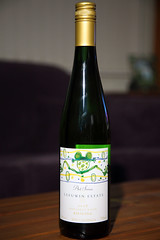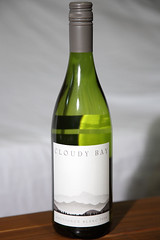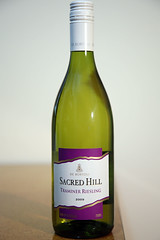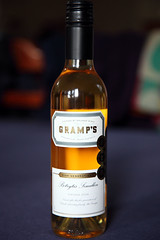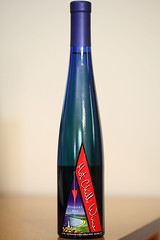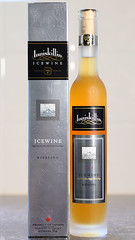 Inniskillin is a Canadian winery, which makes one of the most acclaimed icewines in the world. These are sweet dessert wines produced from grapes that freeze on the vine late in the harvest season with the first frosts of winter. The freezing removes water and concentrates the sugars, allowing deliciously sweet wines to be made without further processing.
Inniskillin is a Canadian winery, which makes one of the most acclaimed icewines in the world. These are sweet dessert wines produced from grapes that freeze on the vine late in the harvest season with the first frosts of winter. The freezing removes water and concentrates the sugars, allowing deliciously sweet wines to be made without further processing.
I’ve reviewed one icewine before, and I’ve tried another once at a wine festival in the German town of Bingen, on the Rhine River (boast, moi?). Both were absolutely delicious. So when I saw this bottle of Inniskillin Riesling Icewine in a local bottle shop, I was immediately attracted to it. Alas, the price tag was around $115, for 375 ml. I held out for a couple of visits, while I read up on Inniskillin online. Everything I found said that these were the pinnacle of icewines. And then I got a 20% discount voucher for the bottle shop, and went in one day to pick up some bottles of other things. While there, I asked the guy about the Inniskillin. He said that they were lucky to have that one bottle in stock – they rarely get them in, as the number of bottles imported to Australia is so few. Given that, I took the plunge and grabbed it, not knowing when I might get the chance to acquire a bottle again.
We opened it on New Year’s Eve, after a quiet dinner at home, relaxing into an evening of TV, and had it with a platter of cheeses. The colour is, as you can see from the photo, a rich, dark gold – darker than any other dessert wine I’ve had. The aroma was fresh and vibrant, with oranges the dominant note. It was slightly thick and syrupy. On the tongue it was sweet, with flavours of orange and marmalade, with a touch of acidity to cut into the sweetness, something like lime. It was nicely balanced, but very sweet, and… disappointingly simple. I was expecting layers of complex flavours developing in the mouth, but there wasn’t much of that going on. There was a hint of Riesling minerality underneath it all, and that slight piercing note in the aroma, but the fruit flavour and sweetness were basically straightforward.
M. put it best when she said it reminded her of Noble One, the benchmark Australian dessert wine, a botrytis Semillon by De Bortoli, and one which we’ve had several times. It’s true – it tasted almost exactly like Noble One. The same orange dominance with a bittersweet marmalade finish and lingering taste. While this is very nice (I love Noble One), it wasn’t what I was hoping for in an internationally acclaimed wine that cost nearly 3 times as much.
So… Inniskillin Riesling Icewine. Good, but not that good. Inniskillin also makes icewine from Vidal, Cabernet Franc, and Tempranillo, so I might try one of those at some point (if I can find any).

